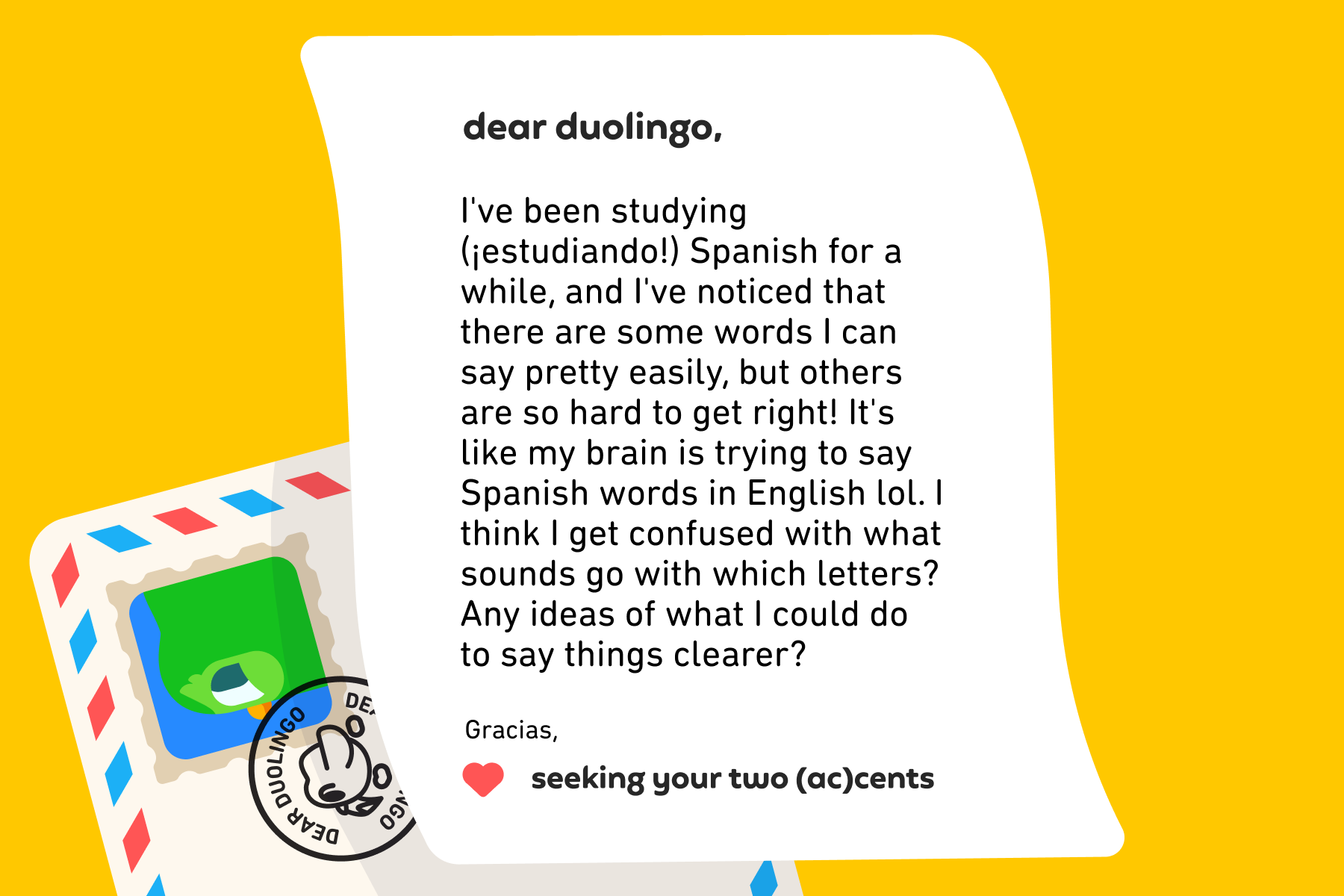Welcome to another week of Dear Duolingo, an advice column just for language learners. Catch up on past installments here.
Hello, learners! Now that you have some general pronunciation tips, this week we'll be sharing some tips especially for Spanish pronunciation. This week we're combining language practice (!), Spanish (!!), and accents (!!!) – and these are a few of my favorite things. 🥰
This week's question:

When thinking about pronunciation in your new language, including Spanish, it's easy to get overwhelmed by the number of sounds and things to remember. So the first tip for Spanish pronunciation is to focus on things that help you communicate, instead of trying to sound some particular way. With that in mind, here are some pointers to make that communication happen!
Pronunciation tips for Spanish words
- Most Spanish words have stress on the second-to-last syllable. In Spanish, accent marks tell you which part of the word is stressed (loudest, emphasized), and if the word doesn't have an accent mark, then the second-to-last syllable is probably where the stress goes: aMIga (friend), coCIna (kitchen), albariCOques (apricots), dibuJAron (they drew).
- Some sounds mean stress is at the end. If there is no written accent mark and the word ends with "d," "l," "r," or "z," then stress is at the end of the word: miTAD (half), iGUAL (equal), entenDER (to understand), efiCAZ (effective).
- It's tempting to pronounce words like in English. Your brain naturally wants to use the pronunciations it knows best, so look out for cognates that look alike in English and Spanish (like universidad and decisión) but that probably have different pronunciations and stress patterns!
| If you see... | The loudest syllable is... |
|---|---|
| an accent mark | the syllable with the accent mark! |
| no accent mark and the word ends with "d," "l," "r," or "z" | the final syllable |
| no accent mark and the word ends with any other letter | the second-to-last syllable |
Pronunciation tips for Spanish vowels
- Spanish vowels are all pronounced fully. In languages like English, Catalan, and Russian, you sort of squish or skip a lot of vowels, turning many of them into a schwa. For example, in "language," we spend a lot of time pronouncing the first "a," and the other vowel turns into "ih" (LANG-gwihj). But in Spanish you'll take the same amount of time to pronounce each vowel. No squishing!
- Spanish vowels are always pronounced the same way. If you know how to pronounce a vowel in one word, you know just how it'll sound in another—and, well, in all words! Spanish "e" always has the same sound, no matter what word it's in, same for Spanish "a," "i," etc. This is much simpler than English, where “a” can be pronounced differently in “bad,” “alive,” or “place.”
- Spanish vowels get right to the point. Spanish vowels might seem shorter than English ones, especially "e" and "o"—so don't let them drag on quite as long as we do in English. If you think of English words like "be" and "go," the vowels last pretty long and we even add a sound on the end, making them even longer (we pronounce "be" more like "beeey" and "go" like "gooow"—can you feel yourself making those sounds at the end?). Instead, think of "freezing" your mouth halfway through saying the vowel; that's about right! Keep Spanish vowels brief and to the point!
- Spanish vowels come alive with the sound of music. The same letter stands for really different sounds in Spanish and English, so it's important to remember the Spanish version of "a," "e," "i," "o," "u," and "y." Here's a trick: use the song "Do-Re-Mi" from The Sound of Music to help learn the vowel sounds – the Spanish "o" always sounds like the “o” in "doe a deer," the Spanish "a" always sounds like the a in "la," etc. The do re mi fa so la ti do vowels are the vowels of Spanish! (Oh, also, "u" is pronounced like the sound in who, glue, or… you!)
| If you see... | What you say is close to... |
|---|---|
| a | "fa" (ha, ma, pa) |
| e | "re" (ray, hey, sleigh) |
| i | "ti" (tea, me, see) |
| o | "do" (doe, go, know) |
| u | "u" (who, glue, you) |
Pronunciation tips for Spanish consonants
- Spanish "s" and "z" are almost always pronounced the same. With the exception of Spain, you can mostly count on "s" and "z" to be pronounced as "s," and not as "z." (Of course, there can be a lot of variation across Spanish dialects!) So casa (house) is pronounced with an "s," pez (fish) has an "s" sound at the end, the name José is pronounced with an "s" in Spanish (even though you often hear it with "z" in English!), etc. (Curious about Spain or these other dialects? Ask us!)
- Spanish "c" has two pronunciations. Spanish "c" is like an English "k," except when it comes before "e" and "i"—then it will instead sound like "s." So in Spanish, cerebro (brain) starts with an "s" sound, and tocino (bacon) also has an "s" sound, while "picante" (spicy), "coco" (coconut) and culebra (snake) have "k" sounds.
- Spanish "g" has two pronunciations. Sound familiar? You know where this is going! In Spanish, pronounce the "g" like in English "go," except before "e" and "i" – then it has a sound like the English "h" in "help." (And in some Spanish varieties it's pronounced with a sound even further back in your throat or is made a bit rougher.) So gente (people) is pronounced like "hente," and gengibre (ginger) has two "h" sounds!
- Spanish "r" has two pronunciations. Wait, this tip is a little different! At the beginning of a word, the Spanish "r" is pronounced the same as "rr," so even though there's only one "r" written, think of it like a trill! This is true for regular words like rojo (red) and reina (queen) as well as names like Roberto. And that second pronunciation of "r"? Read the next tip!
- Spanish "r" inside words can often be thought of as "tt" or "dd." In American English, we pronounce the "tt" of "butter" and the "dd" of "kidding" the same, by touching or tapping our tongues to the roof of our mouths. (They aren't truly "t" or "d" sounds!) Spanish uses this tap sound, too, but in Spanish it's used for a single "r" (except at the beginning of a word). That means the Spanish word para (for) is pronounced a lot like the English word potted—so pronouncing "potted tea" actually sounds a lot like para ti (for you)!
- There's no one way to pronounce the Spanish "rr." Spanish dialects pronounce the Spanish "trill" all kinds of ways – so you can too! Some of the easiest versions for English speakers are to pronounce it like the "zh" sound in "treasure," or even just like the American English "r." That's pretty close to how it's pronounced in Costa Rica!
- Spanish "d" is sometimes "th." When a "d" is in between vowels, like in cada (each) and miedo (fear), it's typically pronounced like the first sound in these. As you get used to pronouncing "d" like "th" in these cases, think about getting your tongue to touch the back of your teeth to get it right! In many Spanish varieties, you'll also hear this pronunciation of "d" at the ends of words, like sed (thirst).
| Letters | Sounds a lot like | Except! |
|---|---|---|
| c | English "k" | "ce" or "ci" sound like English "s" (and in Spain, these sound like "th" in English "think") |
| g | "g" in English "go" | "ge" or "gi" sound like English "h" |
| d | English "d" | In the middle or the end of a word, sounds like "th" in English "these" |
| s | English "s" | * |
| z | English "s" | In Spain, sounds like "th" in English "think" |
| r | "tt" in English "potted" | "r" at the beginning of a word is a trilled "rr" |
| rr | Lots of variety in different dialects! |
* There are some other exceptions here that advanced learners might be interested in. If you want to learn more, write to Dear Duolingo!
Level up: Two tips for advanced learners
Remember how some sounds are really helpful for being understood, and others probably won't get in the way of communication? Just to put some icing on the cake of Spanish pronunciation, here are two tips for more advanced learners:
- Spanish consonants hold it all inside. There is a really subtle, but important, difference in how English and Spanish pronounce the sounds p, t, and k . For reasons I'll only tell you if you really want me to, in English we release a little puff of air after "p," "t," and "k" at the beginning of words—but Spanish does not. Try it! Hold your hand in front of your mouth and say "pot," "tot," and "cot" in English. To get the Spanish pronunciation of these sounds, hold that puff in (we don't puff when we say "bot," "dot," or "got").
- Spanish "t" and "d" touch your teeth. When you pronounce the Spanish "t" and "d," try to get your tongue right to the back of your teeth, practically touching them.
Sounds like there’s a lot to practice!
There are a lot of tips and ideas here, but don't be discouraged! Remember to focus on the sounds and tricks that help you be understood when speaking Spanish, especially if you're a beginner. Start with the vowel sounds and "c" and "g," and move on to the other tips once you're comfortable. You'll get there with practice!
Let us know what other language and learning topics you have questions about. Write to Dear Duolingo at dearduolingo@duolingo.com!



